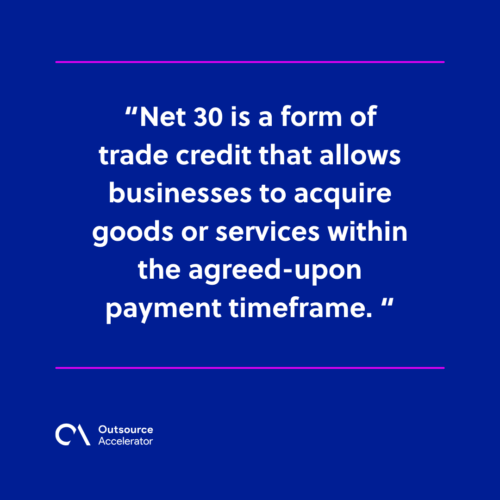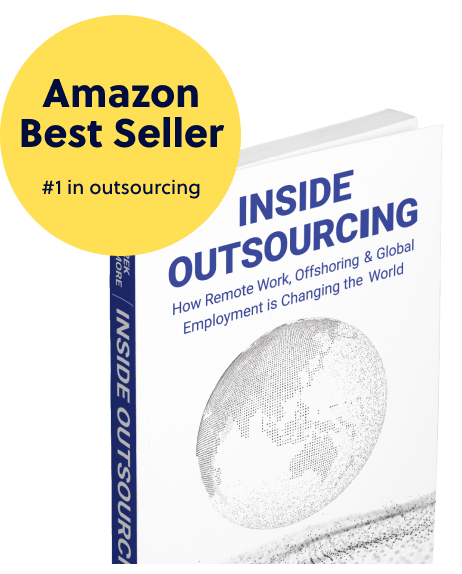Net 30: What it is, how it works, and its benefits

Before you sign a contract, complete the task, and send an invoice to business partners and clients, one crucial step can make or break your cash flow: setting clear payment terms.
For many businesses, Net 30 is the standard choice as it offers a set timeframe for clients to settle their invoices. But why do they rely on this approach, and how can it benefit yours?
Let’s take a closer look.
What does Net 30 mean?
Net 30 is a form of trade credit that allows businesses to acquire goods or services within the agreed-upon payment timeframe. Depending on the client and vendor agreement, the “30” can refer to different starting points.
It might mean 30 days after the sale, 30 days after the goods are delivered, or 30 days after a service is completed. Note that this type of payment term always includes all calendar days, even weekends and holidays.

Common types of businesses that use Net 30 are as follows:
- Accounting
- Consulting
- Hardware
- Marketing companies
- Business services
- Office supplies and equipment
- Graphic design
- Software development
When a vendor extends Net 30 terms, they essentially offer their clients a short-term business loan. This is similar to how banks and credit card companies provide credit to consumers.
If you use this payment term in your business, you should clearly define the payment deadline in contracts to reduce the risk of disputes over due dates.
Net 30 vs. other payment terms
Net 30 is just one of many payment terms used in business transactions. Some vendors offer Net 15 or Net 60, while others require upfront payment or cash on delivery (COD).
- Net 15: The invoice must be paid within 15 days, offering a shorter credit period.
- Net 60: Extends the payment period to 60 days, providing more flexibility but potentially straining vendor cash flow.
- Cash on delivery (COD): Requires full payment upon receipt of goods, eliminating credit risk but limiting purchasing power.
- Due upon receipt: Demands immediate payment once the invoice is issued, ensuring the seller receives funds quickly.
Many businesses favor Net 30 because it projects a steady cash flow and ensures both parties understand payment expectations clearly. With this payment term, clients have a reasonable timeframe to settle invoices, reducing the likelihood of rushed payments.
Smaller enterprises prefer Net 15 because Net 30 and 60 are too long to wait for payment, affecting their cash flow.
How does the Net 30 payment term work
A Net 30 agreement begins when a vendor invoices a client for services. The invoice specifies the Net 30 payment term, indicating that full payment is due 30 days after the invoice date.
Some vendors offer discounts for early payments, such as “2/10 Net 30,” which means the buyer can receive a 2% discount if the invoice is paid within 10 days.
For example, a company purchasing $5,000 worth of office supplies on Net 30 terms receives the invoice on March 1st and the full amount is due by March 31st. If the vendor offers a 2/10 discount, the company can pay $4,900 by March 11th and save $100.
4 Benefits of Net 30 for businesses
Implementing Net 30 payment terms gives businesses a reliable structure for managing financial commitments. Below are some of the key benefits of this payment term.
1. Improves cash flow management
Net 30 payment terms provide greater financial flexibility by allowing clients to purchase goods or services and pay later within 30 days. This helps keep cash available for the company’s essential expenses like payroll, inventory, and growth initiatives.
For service providers, it improves cash flow management and creates a more predictable financial cycle.
2. Builds stronger vendor relationships
Net 30 helps build stronger vendor relationships by creating trust between buyers and sellers. When a partner honors his promise to pay within 30 days, the vendor sees them as reliable, making them more willing to offer discounts or extended dues.
3. Encourages more sales
Vendors offering Net 30 terms attract more buyers who value the flexibility of purchasing now and paying later. This arrangement benefits both parties: sellers see increased sales and buyers gain purchasing power without financial pressure.

4. Improves business credit
Paying Net 30 invoices on time helps build a strong credit profile. A higher credit rating increases eligibility for higher credit limits, better loan terms, and stronger financial partnerships.
Consistently meeting payment deadlines also enhances credibility with suppliers and lenders, positioning the company as a reliable trading partner and borrower.
Net 30 helps businesses get paid early
While Net 30 remains a widely accepted payment term in business, it is essential to evaluate whether it aligns with your company’s financial strategy.
Setting clear payment expectations and ensuring timely payments maximizes trade credit’s benefits, turning it into a strategic advantage rather than a financial risk.







 Independent
Independent




